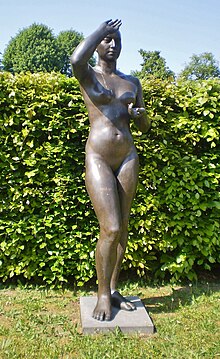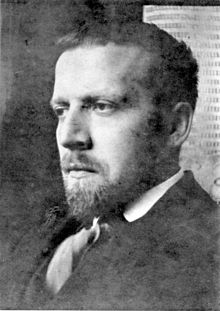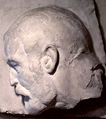August Suter

August Suter (born July 19, 1887 in Basel ; † November 28, 1965 there ) was a Swiss sculptor .
Life
August Suter was born in Basel as the sixth of eleven children. His parents were master bookbinder Johannes Suter (1857–1907) from Eptingen and his wife Katharina Suter-Schaub (1859–1941) from Basel. Burkhard Mangold also lived in the same house at Albanvorstadt 44 . During his bookbinding apprenticeship with his father, August Suter took drawing and painting courses as well as modeling at the general trade school in Basel from 1900 to 1907. For a short time he was also a student at the private painting school of Hermann Meyer (1878–1961), who founded the school in Basel in 1907. In 1914 Suter modeled a portrait of Meyers. The bronze cast is owned by the Kunstverein Basel. After the Second World War, Suter and Meyer had their studios at Frohburgstrasse 4 in Basel. They stayed friends all their lives.
He then began an apprenticeship as a building sculptor and worked for the sculptor Carl Gutknecht , before he went to the Académie Julian in Paris in 1910 and there, on the advice of Rodo (Auguste de Niederhäusern), decided to sculpt. In Paris, lifelong friendships developed with the writer Blaise Cendrars and the English painter Frank Budgen , who initially worked as a model for him. Other close friends were the Swiss poet and translator Siegfried Lang and the German writer and anarchist Johannes Nohl .
From 1911 to 1915 he traveled to Ringgenberg on Lake Brienz during the summer . Suter was in contact with Jakob Schaffner from 1911 to 1916 . This helped Suter to get new orders in Germany. The friendly relationship ended probably because of opposing political worldview.
Suter stayed in Mannheim for several months from 1913 to 1914 . There he portrayed the Swiss professor Fritz Fleiner, who was then teaching in Heidelberg , and later his wife Fanny Fleiner-Veith (1870–1957). The couple became Suter's friends and supporters. Fleiner also made a significant financial contribution to the Suter Memorial for Carl Spitterer and they were the godparents of Suter's sons. Through her, Suter met his wife, the singer Helene Moser (1893–1965), a daughter of the architect Karl Moser , in Zurich .
From 1916 to 1922 Suter worked in Basel, Zollikon and Zurich . Portrait busts as well as building and fountain sculptures are created there. During this time, Suter, his brother Paul and Frank Budgen were very familiar with the Irish writer James Joyce, who lived there in exile.
Between the two world wars, Suter stayed again in Paris, where he also met the sculptor Charles Despiau , whose studio was next to his. In a style based on Aristide Maillol and Charles Despiau, he mainly modeled portraits and nudes. From 1945 to 1965 he worked alternately in Paris and Basel. In Paris he met the sculptor Fritz Bürgin (1917–2003) and the sculptor Louis Léon Weber worked for him as a stonemason in Paris.
In 1917 he married Helene Moser. With her he had three sons, of whom only Claude Suter survived the father. Suter died in November 1965, a few months after his wife's death. Her grave is in the Hörnli cemetery .
Suter's son Claudius Gottfried, called Claude, handed over the artistic estate of his father to his home town of Eptingen in 1975. The estate can be viewed in the August-Suter-Museum after registering with the municipal administration .
plant

Suter's naturalistic oeuvre consists predominantly of female and male nudes , portrait busts , figure compositions and building sculptures. Ludwig Marcuse judged that he was "the most important sculptor of our time". While his work was initially influenced by Rodin and Bourdelle , after the age of thirty he increasingly turned to a «classicism» influenced by Maillol . Gotthard Jedlicka points out a central difference to Rodin in the design of his portrait sculptures: "Wherever Rodin storms, he waits calmly, and each time he embeds the unique rhythm of a special life in the special rhythm of his design".
Quote from August Suter. “All creation is based on vision and spirit. These find their expression through the craft of the matter. The latter process is called art. But the first brings life to life. It must be ultimate truth and, as such, shed light on matter. "
In 1920 Suter created the relief Announcer in the tympanum above the main entrance and three relief figures with the titles Sower and women harvesting grapes and grain for the New Church of Fluntern in Zurich . The Lord's Supper table, which is made of polished black marble , was also designed by Suter . Three stained glass windows in the church were also designed by Suter and executed by Otto Berbig .
His most famous sculpture is the Prometheus and the Soul monument to the Swiss poet and Nobel Prize winner Carl Spitteler in Liestal, on which he worked from 1926 to 1931. Six figures from the years 1915–1918 are located at Amtshaus IV in Zurich (Uraniastrasse). A still unbaked clay bust of James Joyce fell victim to World War II. In 1933 he created two fountain sculptures for the spa fountain in Rheinfelden
On behalf of the Swiss Confederation, Suter created the sculpture L 'Afghane for the World Exhibition in Paris in 1937 . Today it can be seen in Blaricum .
Since 1990 there have been numerous exhibitions in Switzerland, Germany and France.
literature
- Kaspar Birkhäuser (Ed.): Personal dictionary of the Canton of Basel-Landschaft , 1997, pp. 150–151.
- Frank Budgen: Myselves When Young. London 1970.
- Hildegard Gantner-Schlee: Leaflet from the August Suter Museum in Eptingen.
- Gotthard Jedlicka: The sculptor August Suter. In: Das Werk , Volume 14, 1927, pp. 155–160 ( digitized version ).
- Siegfried Lang: The sculptor August Suter. In: Baselbieter Heimatbuch , 9, 1962, pp. 19–32 (with catalog raisonné).
Portrait bust of Blaise Cendrars
Plaster bust, Frank Budgen
1956, People and State , Liestal
Sculpture for Carl Spitteler Prometheus and the soul , Liestal
Grave sculpture for Christoph Eckenstein, Wolfgottesacker cemetery
Grave sculpture for Alice Eckenstein Friedhof Wolfgottesacker
Grave sculpture for Arthur Habich, Waldfriedhof Rheinfelden
Grave sculpture for Paul Scherrer , Hörnli cemetery
Web links
- Suter, August. In: Sikart (as of 2018)
- Milena Oehy: August Suter. In: Historical Lexicon of Switzerland .
- August Suter in the person lexicon of the canton of Basel-Landschaft
- Website of the August Suter Museum
- Works by August Suter
- August Suter in the online archive catalog of the Basel-Stadt State Archives
- Suter and James Joyce (English)
- Figure on the office buildings in Uraniastraße Zurich, for which Frank Budgen was the model in 1916.
Remarks
- ↑ Suter met Fred Sauser (Cendrars real name) in 1898/1899 in secondary school.
- ↑ Suter was one of the few friends who could attend Joyce's funeral in Zurich in 1941.
Individual evidence
- ↑ a b August Suter Museum , eptingen.ch
- ↑ August Suter: Frank Budgen, study for the Prometheus of the Spitteler monument and for the male figure of the allegory "State and Family" in Liestal. Retrieved August 4, 2019 .
- ↑ August Suter: Some Reminiscences of James Joyce. In: James Joyce Quarterly , Vol. 7, No. 3, Spring, 1970, pp. 191-198.
- ↑ Gotthard Jedlicka : The sculptor August Suter. In: Das Werk , Volume 14, 1927, p. 160.
- ↑ Milena Oehy: August Suter. In: Historical Lexicon of Switzerland .
- ↑ Literary History of the Present , Vol. 1, Berlin 1925, p. 322.
- ↑ The Suter Museum leaflet by the art historian Hildegard Gantner-Schlee
- ↑ In an unpublished letter to Siegfried Lang in the possession of the Basel University Library, he emphasizes the great influence of Maillol's “Venus” on his work.
- ↑ Gotthard Jedlicka: The sculptor August Suter. In: Das Werk , Volume 14, 1927, p. 160.
- ^ Building Department of the City of Zurich: Building Department of the City of Zurich: Reformed Churches of the City of Zurich. Special inventory. Zurich 2006, pp. 152–154.
- ↑ August Suter: Some Reminiscences of James Joyce. In: James Joyce Quarterly , Vol. 7, No. 3, Spring, 1970, p. 198.
- ^ Fricktaler Museum: 1933, Kurbrunnenskulpuren in Rheinfelden. Retrieved August 9, 2019 .
- ↑ Hans Berger: Kurbrunnenskulptur, photo no.73.Retrieved on August 9, 2019 .
- ↑ August Suter Museum: Sculpture L 'Afghane, Paris World Exhibition 1937. Retrieved on November 5, 2019 .
| personal data | |
|---|---|
| SURNAME | Suter, August |
| BRIEF DESCRIPTION | Swiss sculptor |
| DATE OF BIRTH | July 19, 1887 |
| PLACE OF BIRTH | Basel |
| DATE OF DEATH | November 28, 1965 |
| Place of death | Basel |








